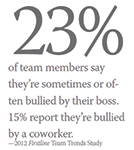Got bullies in your veterinary practice?
When your workplace bully becomes unbearable, strike back with these tips--before the situation gets grizzly. Check out these seven species of bullies-and tips to bear down.
You're barely hanging on. As you walk into work, your stomach ties itself in knots. You'd rather be hibernating. This is the feeling a bully bear creates in the workplace. Most of us have had a run in with one at some point. In a nationwide poll by the Employment Law Alliance, 45 percent of American workers claim they have at some point experienced abuse in the workplace.

(THINKSTOCK/IRONTRYBEX)
With careful research and study of these beasts in their native environments, we've identified seven species of bully bears. Let's discuss a few of the most common types of bullies, including their care and feeding and how to bite back and regain control in the workplace.
The pander bear
This species thinks we're still in grade school, fighting to come out on top of the social ladder. Part of this is human nature: to form groups with similar people, even if it excludes others. It may surprise you that even adults will watch a popular TV show just to be able to discuss it at work the next day with the group. Adults also tease and gang up on other employees to fit into a group.
Bear down: It's a bad idea to give in and just join the clique. Bosses will consider cliques in the workplace as part of your identity, which can interfere with evaluations and ultimately promotions and raises. The other disadvantage is that in a clique, you are mostly interacting with similar people rather than branching out and getting to know a more diverse group of workers.
Don't engage in gossip with the clique. And treat its members with respect and professionalism, even if it's not returned. Ultimately, you're at work to make a living and cultivate a career, not to be the most popular bear in the square. Many cliques at work are filled with lower achievers who will only inhibit your growth. As Kathi Elster, co-author of "Mean Girls at Work" (McGraw-Hill, 2012) and "Working With You is Killing Me" (Business Plus, 2007), states, "While they wield social power, they can decide who is popular and who is not—and they are not usually respected professionally."
The grizzly bear
This species of bully often makes its habitat in human and veterinary hospitals. It takes confidence to work in medical professions. Sadly, sometimes that confidence can turn into egotistical behavior—and may even lead to disrespect toward team members and associates.
You may find no matter how meticulous you are anticipating this bully's needs, she will inevitably find a way that you fell short—and promptly point it out. She often acts disrespectful but can't bear confrontation when you call her on her unbearable behavior. Sometimes you must give up on trying to be a friend.

Bear down: Be professional and maintain a positive working relationship. Initiate a genuine conversation, and find ways to try to improve your relationship to benefit patients. You may even want ask a supervisor to be present if your attempts to correct the behavior don't bear fruit. Most important, don't allow the condescending behavior to continue, as it will draw a target on your back.
The two-faced bear
On your break, you and Harvey swap stories and laugh about your weekend. Later, you hear Harvey's gossiping about you and saying he's offended by a joke you made. But he never shared his concerns with you.
Bear down: Bring this issue to bear with your bully. They usually despise confrontation and expect they will not have to face you if they're sneaky. Being professional and asking Harvey to come to you with his concerns instead of speaking behind your back will usually at least release you as potential prey.
The sloth bear
This bully likes to take her workload and dispense it amongst the team while she does very little. She projects the illusion she's the overachiever and collects the credit from management. I can remember working with a team member we'll call Mary who would float around to the different areas she needed to be in throughout the day, but the entire team was constantly completing Mary's work for her. The team would prep her patient, log her work, clean her workspace and so on. The illusion was that Mary was busy getting lots done. But the team knew the truth.
Bear down: Assuming it doesn't interfere with the welfare of a patient, it's a good idea to refrain from picking up Mary's slack, even if it can be frustrating. Start saying no when she tries to pile on tasks. When appropriate, explain you're busy with your work and can't help.
The dancing bear
This bully has dreams of climbing to the top and believes if she simply assumes that position, she'll receive the title. She tends to hoard tasks and orders other employees around.
Bear down: Bear witness about this bully's behavior to your true supervisor. Often this species of bully will back down and become sheepish in front of the supervisor.
The bad news bear
This type of bully is the worst when she's the supervisor. You broach a concern with this bully and the conversation appears to go smoothly. The next day you come in and she tells you how angry she was when you spoke. And she may have even complained to your manager. The behavior can almost seem bipolar, and these bullies can be some of the most difficult to work with.
Bear down: The best solution is to be even-keeled. And don't rely on these types of bullies as confidants. Of course, if this behavior becomes routine, it's time to bring it to a higher level manager, if you have one.
The mall cop bear
This bully will constantly create roadblocks to impede the success of others and deny access to the resources—and even to physical tools—needed to get the job done. She may feel that inhibiting teammates makes her look better. For example, I worked with a technician who would take newbies and students under her wing. But instead of helping them learn and spreading her knowledge, she would observe their mistakes and point them out to supervisors. This behavior is damaging and often interferes with patients' well-being.
Bear down: Focus on your own work and try to make all interactions with this bully positive. It's easier if these bullies aren't involved in your duties and projects. You can also positively reinforce what they do well on their own to reduce their need to inhibit others' successes. If they regularly interfere with your job or remove the tools you need to complete tasks, involve your supervisor.
When bullies abound, there's higher turnover, more absenteeism and a lack of productivity. Make sure your practice has an anti-bullying policy in your handbook that addresses the definition of bullying, the different kinds of bullies, the reporting procedure and the consequences. And teach new employees that you don't tolerate gossip or bullying behavior. Then create a strong workforce of mature, supportive team members who rise up against bully behaviors before they become unbearable.
Oriana Scislowicz, BS, LVT, VDT, is a technician in Richmond, Va.